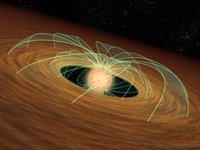 | Mission: Spitzer Space Telescope (SST), Spacecraft: Spitzer Space Telescope (SST), Product Size: 3200 samples x 2400 lines. |
Original Caption Released with Image: This artist's animation demonstrates how a dusty planet-forming disk can slow down a whirling young star, essentially saving the star from spinning itself to death. Evidence for this phenomenon comes from NASA's Spitzer Space Telescope.
The movie begins by showing a developing star (red ball). The star is basically a giant ball of gas that is collapsing onto itself. As it shrinks, it spins faster and faster, like a skater folding in his or her arms. The green lines represent magnetic fields.
As gravity continues to pull matter inward, the star spins so fast, it starts to flatten out. The same principle applies to the planet Saturn, whose spin has caused it to be slightly squashed or oblate.
A forming star can theoretically whip around fast enough to overcome gravity and flatten itself into a state where it can no longer become a full-fledged star. But stars don't spin out of control, possibly because swirling disks of dust slow them down. Such disks can be found orbiting young stars, and are filled with dust that might ultimately stick together to form planets.
The second half of the animation demonstrates how a disk is thought to keep its star's speed in check. A developing star is shown twirling inside its disk. As it turns, its magnetic fields pass through the disk and get bogged down like a spoon in molasses. This locks the star's rotation to the slower-turning disk, so the star, while continuing to shrink, does not spin faster.
Spitzer found evidence for star-slowing disks in a survey of nearly 500 forming stars in the Orion nebula. It observed that slowly spinning stars are five times more likely to host disks than rapidly spinning stars.
Image Credit: NASA/JPL-Caltech.
NASA images generally are not copyrighted. Unless otherwise noted, images and video on JPL public web sites (public sites ending with a jpl.nasa.gov address) may be used for any purpose without prior permission. The endorsement of any product or service by Caltech, JPL or NASA must not be claimed or implied.
Leave a comment, make a request, Let this small sampling be a guide to better quality, more plentiful, public domain, royalty free, copyright free, high resolution, images, stock photos, jpeg, jpg, free for commercial use, clip art, clipart, clip-art. more at Public Domain Clip Art and clip art or public domain and Space or NASA and Spitzer Space Telescope or Space Science and spacecraft or JPL and California Institute of Technology or stars













No comments:
Post a Comment